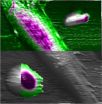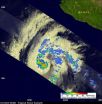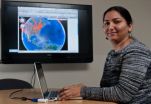(Press-News.org) WEST LAFAYETTE, Ind. - Researchers are making progress in developing a system that measures the mechanical properties of living cells, a technology that could be used to diagnose human disease and better understand biological processes.
The team used an instrument called an atomic force microscope to study three distinctly different types of cells to demonstrate the method's potentially broad applications, said Arvind Raman, a Purdue University professor of mechanical engineering.
For example, the technique could be used to study how cells adhere to tissues, which is critical for many disease and biological processes; how cells move and change shape; how cancer cells evolve during metastasis; and how cells react to mechanical stimuli needed to stimulate production of vital proteins. The technique could be used to study the mechanical properties of cells under the influence of antibiotics and drugs that suppress cancer to learn more about the mechanisms involved.
Findings have been posted online in the journal Nature Nanotechnology and will appear in the December print issue. The work involves researchers from Purdue and the University of Oxford.
"There's been a growing realization of the role of mechanics in cell biology and indeed a lot of effort in building models to explain how cells feel, respond and communicate mechanically both in health and disease," said Sonia Contera, a paper co-author and director of the Oxford Martin Programme on Nanotechnology and an academic fellow at Oxford physics. "With this paper, we provide a tool to start addressing some of these questions quantitatively: This is a big step."
An atomic force microscope uses a tiny vibrating probe to yield information about materials and surfaces on the scale of nanometers, or billionths of a meter. Because the instrument enables scientists to "see" objects far smaller than possible using light microscopes, it could be ideal for "mapping" the mechanical properties of the tiniest cellular structures.
"The maps identify the mechanical properties of different parts of a cell, whether they are soft or rigid or squishy," said Raman, who is working with doctoral student Alexander Cartagena and other researchers. "The key point is that now we can do it at high resolution and higher speed than conventional techniques."
The high-speed capability makes it possible to watch living cells and observe biological processes in real time. Such a technique offers the hope of developing a "mechanobiology-based" assay to complement standard biochemical assays.
"The atomic force microscope is the only tool that allows you to map the mechanical properties - take a photograph, if you will - of the mechanical properties of a live cell," Raman said.
However, existing techniques for mapping these properties using the atomic force microscope are either too slow or don't have high enough resolution.
"This innovation overcomes those limitations, mostly through improvements in signal processing," Raman said. "You don't need new equipment, so it's an economical way to bump up pixels per minute and get quantitative information. Most importantly, we applied the technique to three very different kinds of cells: bacteria, human red blood cells and rat fibroblasts. This demonstrates its potential broad utility in medicine and research."
The technique is nearly five times faster than standard atomic force microscope techniques.
INFORMATION:
The Nature Nanotechnology paper was written by Raman; Cartagena; Sonia Trigueros, a Senior Research Fellow in the Oxford Martin Programme on Nanotechnology; Oxford doctoral student Amadeus Stevenson; Purdue instructor Monica Susilo; Eric Nauman, an associate professor of mechanical engineering; and Contera.
The National Science Foundation and Engineering and Physical Sciences Research Council of the U.K. funded the research.
Related websites:
Arvind Raman:
https://engineering.purdue.edu/ME/People/ptProfile?id=12884
Birck Nanotechnology Center:
http://www.nano.purdue.edu
Discovery Park:
http://purdue.edu/discoverypark
National Science Foundation:
http://www.nsf.gov/
IMAGE CAPTION:
This artist's conception depicts the use of an atomic force microscope to study the mechanical properties of cells, an innovation that might result in a new way to diagnose disease and study biological processes. Here, three types of cells are studied using the instrument: a rat fibroblast is the long slender cell in the center, an E coli bacterium is at the top right and a human red blood cell is at the lower left. The colored portions show the benefit of the new technique, representing the mechanical properties of the cells, whereas the gray portions represent what was possible using a conventional approach. (Purdue University image/Alexander Cartagena)
A publication-quality image is available at http://news.uns.purdue.edu/images/2011/raman-cells.jpg
Abstract of the research in this release is available at: http://www.purdue.edu/newsroom/research/2011/111121RamanCells.html
New medical, research tool possible by probing cell mechanics
2011-11-22
ELSE PRESS RELEASES FROM THIS DATE:
Future prostate cancer treatments might be guided by math
2011-11-22
COLUMBUS, Ohio – Scientists have designed a first draft of a mathematical model that someday could guide treatment decisions for advanced prostate cancer, in part by helping doctors predict how individual patients will respond to therapy based on the biology of their tumors.
These decisions would apply to treatment of cancer that has already spread beyond the prostate gland or that has recurred after initial treatments, such as surgery or radiation. Patients with this more advanced prostate cancer receive a therapy called androgen ablation, which inhibits production of ...
Use of technology-rich learning environment reveals improved retention rates
2011-11-22
Researchers at Rochester Institute of Technology have found that use of a technology-rich learning environment in several undergraduate engineering-technology courses has improved learning and decreased withdrawals from, or failing grades in, the courses.
They found that more than 90 percent of students involved stated that using the technology-rich environment—which includes a combination of tablet PCs, collaborative software, and multiple projection screens capable of capturing and retaining graphics and notations—helped them learn and retain the information better ...
Life-threatening condition in preemies linked to blood type
2011-11-22
MAYWOOD, Ill. -- Many premature infants suffer a life-threatening destruction of intestinal tissue called necrotizing enterocolitis (NEC).
Now a Loyola University Medical Center study has identified a major risk factor for NEC: Preemies with the AB blood type who develop NEC are nearly three times as likely to die from it as preemies with other blood types.
The finding suggests that a simple change in blood transfusion practices in neonatal ICUs could significantly reduce the incidence of NEC.
The study is published online ahead of print in the Journal of Perinatology. ...
Canadian breast cancer screening guidelines would cost thousands of lives
2011-11-22
The American College of Radiology today denounced new breast cancer screening guidelines by the Canadian Task Force on Preventive Health (CTFOPH), which recommend against annual screening of women ages 40-49 and would extend time between screens for older women.
An ACR news release said "the CTFOPH guidelines ignore results of recent landmark randomized control trials which show that regular screening reduces breast cancer deaths in these women by approximately a third" and that "While implementation of the CTFOPH guidelines may save money on screening costs, the result ...
KLAS Offers Providers New Pharmacy-Focused Research
2011-11-22
Healthcare research firm KLAS announces a new pharmacy report designed to help providers attending the 2011 American Society of Health-System Pharmacists (ASHP) conference make informed pharmacy technology buying decisions. With thinning wallets, providers are becoming more strategic in their technology purchasing decisions--and pharmacy is no exception.
The "KLAS Pharmacy Buyers Guide" offers product ratings for more than 100 software and equipment offerings, all based on the feedback of thousands of healthcare providers. Each rated product has been given ...
Late season Hurricane Kenneth forms in the eastern Pacific
2011-11-22
The hurricane season in the eastern Pacific isn't over and Hurricane Kenneth serves as a reminder that the season ends November 30. NASA satellite imagery shows Kenneth more organized than it appeared on Sunday, Nov. 20 and became a late season hurricane earlier today.
Kenneth began as the thirteenth tropical depression and that formed on Saturday, November 19, about 480 miles south of Acapulco, Mexico. On Sunday, November 29 at 0300 UTC (11 p.m. EST, Nov. 19) the National Hurricane Center noted that the center of Tropical Depression 13E was further north than previously ...
All systems go for next communication spacecraft
2011-11-22
The most recent evaluations of NASA's Tracking and Data Relay Satellite (TDRS) project confirmed all systems go for a third generation upgrade of the orbiting communications network. TDRS-K is scheduled for launch aboard an Atlas V rocket from Cape Canaveral, Florida in the fall of 2012.
Approval to move forward came during a recent Agency Project Management Council (APMC) meeting at NASA Headquarters. "I am very proud of the entire TDRS civil servant and contractor team for successfully completing this milestone and demonstrating that the TDRS project is ready to proceed ...
MU researchers find synthetic RNA lessens severity of fatal disease
2011-11-22
COLUMBIA, Mo. – A team of University of Missouri researchers have found that targeting a synthetic molecule to a specific gene could help the severity of the disease Spinal Muscular Atrophy (SMA) – the leading genetic cause of infantile death in the world.
"When we introduced synthetic RNA into mice that carry the genes responsible for SMA, the disease's severity was significantly lowered," said Chris Lorson, researcher at the Bond Life Sciences Center and professor in the Department of Veterinary Pathobiology and the Department of Molecular Microbiology and Immunology. ...
After 25 years, sustainability is a growing science that's here to stay
2011-11-22
BLOOMINGTON, Ind. -- Sustainability has not only become a science in the past 25 years, but it is one that continues to be fast-growing with widespread international collaboration, broad disciplinary composition and wide geographic distribution, according to new research from Los Alamos National Laboratory and Indiana University.
The findings, published today in the Proceedings of the National Academy of Sciences, were assembled from a review of 20,000 academic papers written by 37,000 distinct authors representing 174 countries and over 2,200 cities. Authors of the ...
Bullritos Pioneers New Online Ordering App for Facebook
2011-11-22
Bullritos, a regional burrito chain, is breaking new ground with the launch of a new online ordering application designed by OLO Online Ordering. Starting today, fans of Texas-based Bullritos can order, pay and confirm their spot as first in line -- all without leaving the regional chain's Facebook page.
Bullritos is the first restaurant brand in the country to launch an online ordering application on Facebook that allows its 5,000 fans the ability to view and order from the restaurant's full menu, repeat previous orders, pay securely using a credit card, and confirm ...





